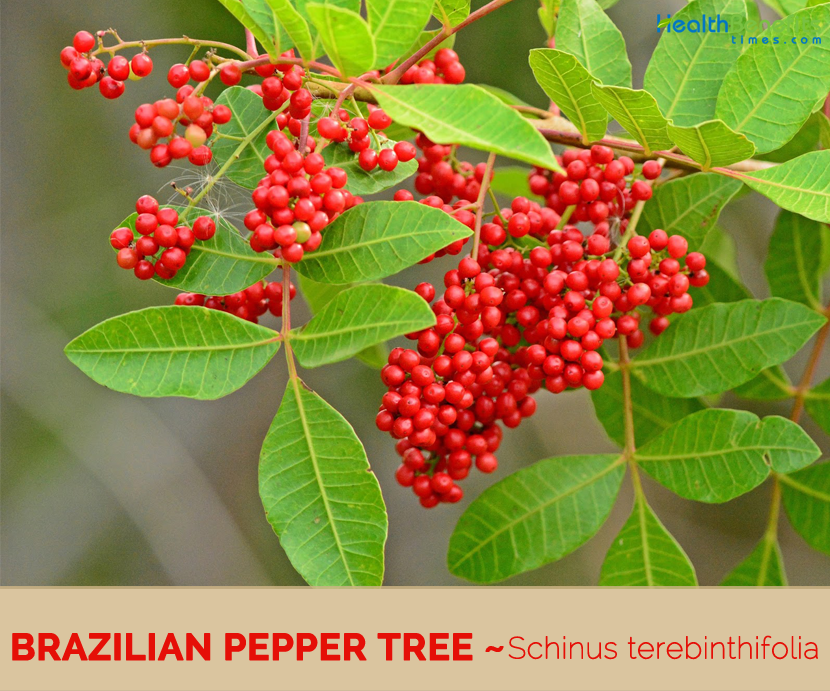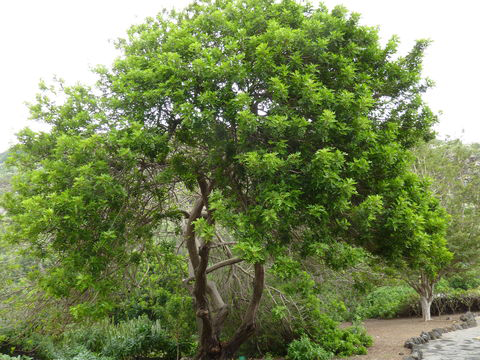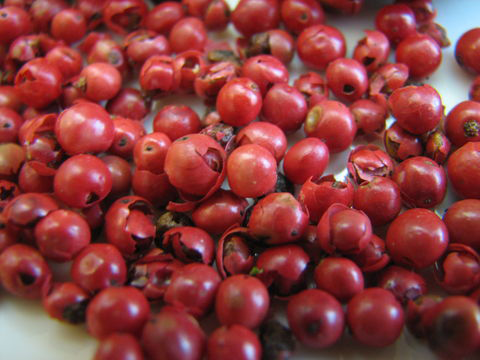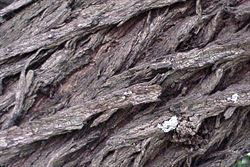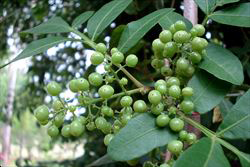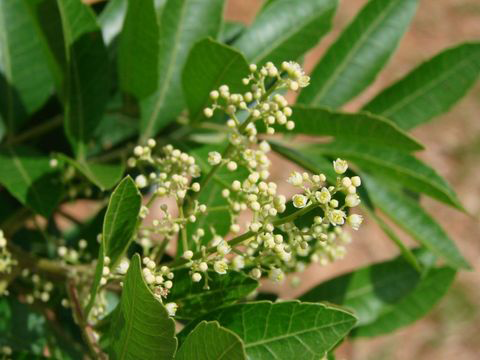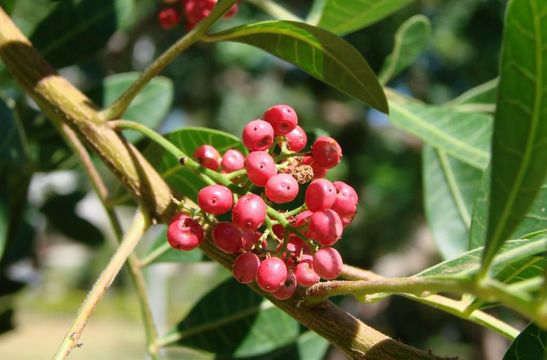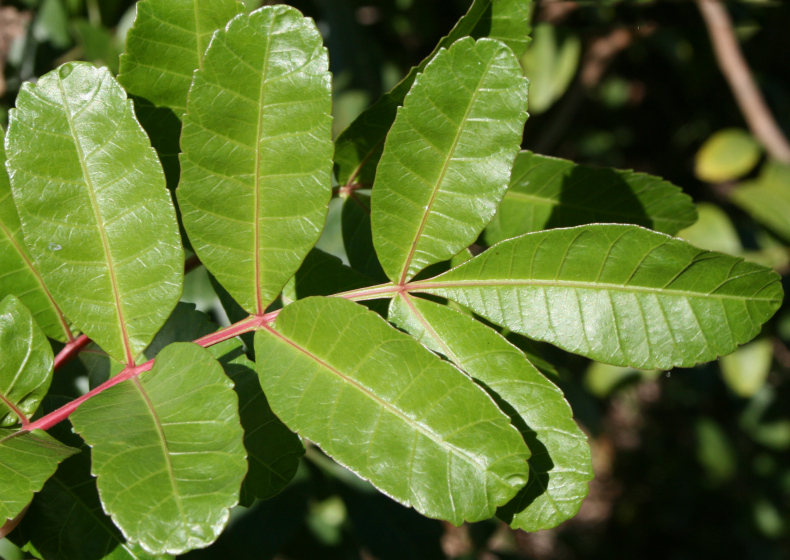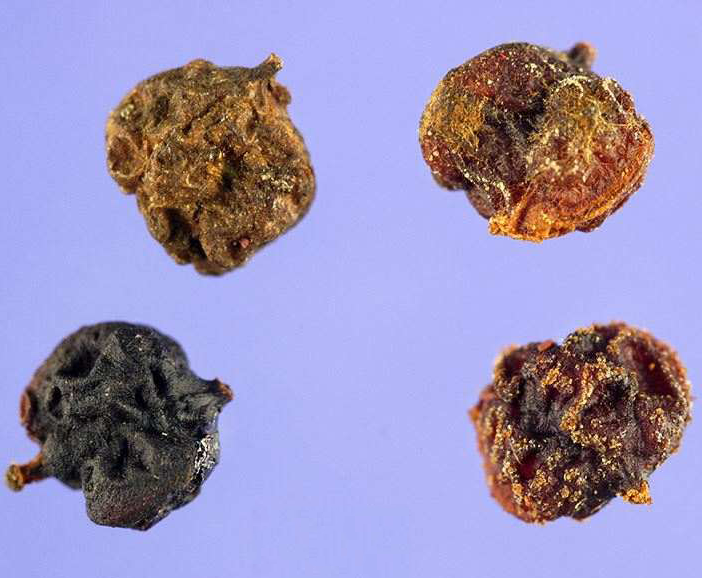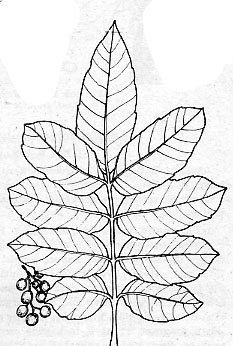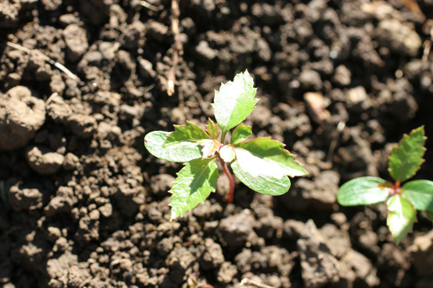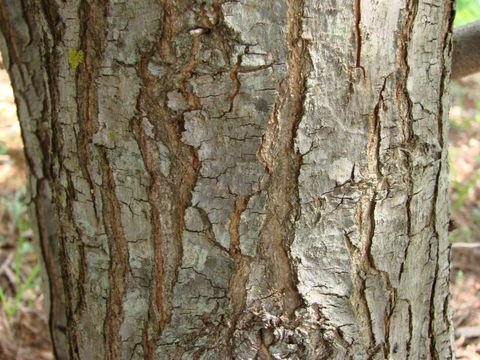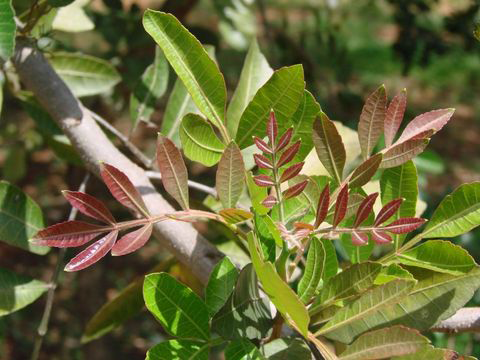As a member of the Schinus genus it is known as a “pepper tree,” although it is not a true pepper. Even so, Schinus molle or the Peruvian Pepper, a close relative of the Brazilian Pepper, is the source of the pink peppercorns that you sometimes see in gourmet pepper mills. Brazilian Pepper is also known as “Hawaiian Christmas Berry” or “Florida Holly” because its red berries mature in December/ January and are sometimes used as Christmas decorations. Genus name comes from the Greek name schinos for the mastic tree which this genus resembles in that the trees exude a mastic-like juice. Specific epithet means pertaining to turpentine and foliage. Supposedly, for the aromatic foliage.
Plant Description
Brazilian pepper tree is an evergreen shrub or small tree that grows about 3-10 m tall (occasionally 15 m) with a trunk 10-30 cm diameter (occasionally 60 cm). Bark is gray, smooth or becoming furrowed into long narrow flat ridges. Twigs are light brown, finely hairy when young, with many raised dots (lenticels). Sap is aromatic, resinous, suggesting turpentine, turning blackish upon exposure. It is previously planted as a garden ornamental, but now as a weed in coastal areas. The tree is quite resinous and aromatic, particularly when the leaves are crushed. The younger branches are covered with small whitish colored spots (i.e. lenticels) and its new stems are softly hairy (i.e. pubescent) or sparsely hairy (i.e. puberulent). Bark of older stems is dark brown or blackish in color, very rough and deeply ridged.
Leaves
Leaves are alternate pinnate 7.5–15 cm long, with narrowly winged green finely hairy axis of 2.5–7.5 cm and mostly 5, 7, or 9 (3–13 or more in varieties) stalk less leaflets paired except at end. Leaflets are glabrous, elliptical or oblong, 2.5–5 cm long and 1.3–2 cm wide, the largest at the end of the leaf to 7.5 cm by 2.5 cm, short-pointed at both ends, often with inconspicuous small blunt teeth toward apex, slightly thickened, hairless or nearly so, upper surface shiny green with several straight side veins, and lower surface dull light green. The leaves are highly aromatic when crushed, giving off a peppery or turpentine-like smell.
Flower
Flower about 3 mm long and broad consists of calyx of five tiny pointed green sepals; corolla of five spreading white petals less than 3 mm long; 10 stamens attached at base of large ring-shaped disk; and pistil with rounded ovary, short style, and dot stigma. Flowering occurs from September through November and fruits are usually mature by December.
Fruit
The fruits are drupes many in dense clusters, glossy, with calyx at base, with aromatic resinous brown pulp, slightly bitter, 4-5 mm in diameter. The fruit is green and juicy at first, becoming bright red on ripening, and 6 mm wide. The red skin dries to become a papery shell surrounding the seed. The seed is single, elliptical, light brown, less than 3 mm long.
Traditional uses and benefits of Brazilian pepper tree
- Liquid tincture from the bark is used as a stimulant and tonic.
- It has been used as a diuretic and for the treatment of tumors.
- Remedial healers have used it topically for gout, syphilis, as well as cases or rheumatism.
- Other folk healers recommend the leaves and fruit to be added to baths to help heal open wounds or ulcers on the body.
- South African people steep the leaves and make a tea to heal colds faster.
- Dried leaves are used in Argentina for respiratory and urinary infections.
- Brazilian peppertree is described to be an astringent, antibacterial, diuretic, digestive stimulant, tonic, antiviral, and wound healer.
- Sap is used as a mild laxative and a diuretic, and the entire plant is used externally for fractures and as a topical antiseptic in Peru.
- Entire plant is used externally for fractures and as a topical antiseptic.
- Oleoresin is used externally as a wound healer, to stop bleeding, and for toothaches, and it is taken internally for rheumatism and as a purgative.
- Leaf tea is used to treat colds, and a leaf decoction is inhaled for colds, hypertension, depression, and irregular heartbeat in South Africa.
- Bark tea is used as a laxative, and a bark-and-leaf tea is used as a stimulant and antidepressant in Brazilian amazon.
- Decoction is made with the dried leaves and is taken for menstrual disorders and is also used for respiratory and urinary tract infections and disorders in Argentina.
- It is used for many conditions in the tropics, including menstrual disorders, bronchitis, gingivitis, gonorrhea, gout, eye infections, rheumatism, sores, swellings, tuberculosis, ulcers, urethritis, urogenital disorders, venereal diseases, warts, and wounds. In Brazilian herbal medicine today, the dried bark and/or leaves are employed for heart problems (hypertension and irregular heart beat), infections of all sorts, and menstrual disorders with excessive bleeding, tumors, and general inflammation.
- Liquid extract or tincture prepared with the bark is used internally as a stimulant, tonic, and astringent, and externally for rheumatism, gout, and syphilis.
- Brazilian pepper tree has been used as a remedy for ulcers, respiratory problems, wounds, rheumatism, gout, diarrhea, skin ailments and arthritis, as well as to treat tumors and leprosy in folk medicines.
- Stem bark is used to treat inflammations, scabies, sore throat and itching.
Culinary Uses
- Berries are used to make syrups, vinegar, and beverages because of the spicy flavor.
- It can be added to wines and used as a pepper.
- Seeds can be used as a spice, adding a pepper-like taste to food.
- In some countries, dried and ground berries are used as a pepper substitute or as an adulterant of black pepper (Piper nigrum).
Other Facts
- Its bright red berries and brilliant green foliage are used frequently as Christmas decorations.
- They have been used in the perfume industry.
Precautions
- Brazilian pepper has an aromatic sap that can cause skin reactions (similar to poison ivy burns) in some sensitive people – although the reaction is usually weaker than that induced by touch of the closely related Lithraea molleoides.
- Contact with the “sap” from a cut or bruised tree can result in rash, lesions, oozing sores, severe itching, welts, and reddening and swelling (especially of the eyes).
- If berries are eaten they may cause vomiting and diarrhea.
- Sap may cause dermatitis and eye irritation.
- When flowering, the tree may cause sneezing, asthma-like reactions and headache.
- Contact with most parts of Brazilian pepper can cause an itchy skin rash and sometimes inflammation and swelling of the face and eyes.
- Flowers and fruits can cause respiratory irritation.
References:
https://davesgarden.com/guides/pf/go/1911/
http://www.hear.org/pier/species/schinus_terebinthifolius.htm
https://www.cabi.org/isc/datasheet/49031
http://www.missouribotanicalgarden.org/PlantFinder/PlantFinderDetails.aspx?kempercode=e921
https://plants.usda.gov/core/profile?symbol=SCTE
http://www.theplantlist.org/tpl1.1/record/kew-2480191
https://en.wikipedia.org/wiki/Schinus_terebinthifolia
https://plants.ifas.ufl.edu/plant-directory/schinus-terebinthifolia/
http://www.sms.si.edu/irlspec/schinus_terebinthifolius.htm
https://www.itis.gov/servlet/SingleRpt/SingleRpt?search_topic=TSN&search_value=28812#null
http://www.worldagroforestry.org/treedb/AFTPDFS/Schinus_terebinthifolius.PDF
Comments
| Brazilian Pepper Tree Quick Facts | |
|---|---|
| Name: | Brazilian Pepper Tree |
| Scientific Name: | Schinus terebinthifolia |
| Origin | Subtropical and tropical South America |
| Colors | Drupes many in dense clusters, bright red, with calyx at base, with aromatic resinous brown pulp, slightly bitter, 4-5 mm in diameter. |
| Shapes | Green when young turning to bright red as they matures |
| Taste | Slightly bitter |
| Health benefits | Beneficial for colds, hypertension, depression, irregular heartbeat, menstrual disorders, urinary tract infections |
| Name | Brazilian Pepper Tree |
|---|---|
| Scientific Name | Schinus terebinthifolia |
| Native | Subtropical and tropical South America (southeastern Brazil, northern Argentina, and Paraguay) |
| Common Names | Brazilian peppertree, aroeira, rose pepper, broadleaved pepper tree, wilelaiki, Christmasberry, and Florida Holly, Brazilian holly, Brazilian pepper, Brazilian pepper tree, broad leaf pepper tree, broad-leaved pepper tree, Christmas berry, Christmas berry tree, Japanese pepper, pepperina, schinus, South American pepper |
| Name in Other Languages | Afrikaans: Brasiliaanse peperboom Argentina: Chichita Bahamas: Christmas-berry tree Chinese: Ba xi ru xiang (巴西乳香), Ba xi hu jiao mu (巴西胡椒木) , Xiao ru xiang (肖乳香) Cuba: Copal, falso copal, racimos de rubí Czech: Pepř růžový, Růžový pepř Danish: Rød Peber Dutch: Roze peper English: Bahamian holly (USA), Brazil pepper, Brazilian peppertree, Christmasberry tree, Florida holly, Pink pepper, Warui Fijian: Warui French: Poivre de Bourbon, Poivre rose, Schinus à feuille de térébinthe, baie rose, encent, faux poivre du Brésil, faux poivrier, poivre marron, poivrier d’Amérique German: Brasilianischer Pfeffer, Brasilianischer Pfefferbaum, Rosé-Pfeffer, Rosa Pfeffer Hawaiian: Naniohilo, wilelaiki Hungarian: RózsaszÃn bors, Brazilbors Icelandic: Rósapipar Japanese: Sanshou modoki (サンショウモドキ) Paraguay: Molle-i Portuguese: Aroeira (Brazil), Aroeira brasileira, Aroeira da praia, Aroeira do brejo, Aroeira do Paraná, Aroeira do sertão, Aroeira mansa (Brazil), Aroeira pimenteira (Brazil), Aroeira vermelha (Brazil), Aroeirinha-do-campo, Aroeirinha-preta (Brazil), Bálsamo, Cabuà , Cambuà , Coraciba (Brazil), Coraçao-de-bugre , CorneÃba, Fruta-de-cotia (Brazil), Fruta-de-raposa, Fruta-de-sabiá (Brazil), Pimenta rosa, Pimenteira bastarda, Pimenteira-do-peru. Russian: Shinus terpentinovyi (Шинус терпентиновый), Схинус фисташколистный Skhinus fistashkolistnyi, Схинус живичнолистный Skhinus zhivichnolistnyi South Africa: Brasiliaanse peperboom Spanish: Arveira , Chichita (Argentina), Copal, Pimienta de Brasil, Pirul, Terebinto (Argentina), Turbinto, Pimentero brasileño Swedish: Rosépeppar USA: Bahamian holly, Christmasberry tree, Florida holly USA/Hawaii: Naniohilo; wilelaiki |
| Plant Growth Habit | Evergreen shrub or small tree |
| Plant Size | 3-10 m tall (occasionally 15 m) |
| Root | Shallow root system |
| Twigs | Light brown, finely hairy when young, with many raised dots |
| Bark | Gray, smooth or becoming furrowed into long narrow flat ridges |
| Trunk | Trunk has 10-30 cm diameter (occasionally 60 cm) |
| Leaf | Alternate pinnate 7.5–15 cm long, with narrowly winged green finely hairy axis of 2.5–7.5 cm and mostly 5, 7, or 9 (3–13 or more in varieties) stalk less leaflets paired except at end |
| Leaflets | Glabrous, elliptical or oblong, 2.5–5 cm long and 1.3–2 cm wide, the largest at the end of the leaf to 7.5 cm by 2.5 cm, short-pointed at both ends, often with inconspicuous small blunt teeth toward apex, slightly thickened, hairless or nearly so, upper surface shiny green with several straight side veins, and lower surface dull light green. |
| Flowering Periods | September through November |
| Flower | 3 mm long and broad consists of calyx of five tiny pointed green sepals; corolla of five spreading white petals less than 3 mm long; 10 stamens attached at base of large ring-shaped disk; and pistil with rounded ovary, short style, and dot stigma. |
| Fruit Shape & Size | Drupes many in dense clusters, bright red, with calyx at base, with aromatic resinous brown pulp, slightly bitter, 4-5 mm in diameter |
| Fruit Color | Green when young turning to bright red as they matures |
| Seed | Single, elliptical, light brown, less than 3 mm long |
| Varieties/Types |
|
| Flavor/Aroma | Peppery or turpentine-like smell |
| Taste | Slightly bitter |
| Plant Parts Used | Leaves, bark, fruit, seeds, resin, and oleoresin |
| Season | December |
| Lifespan | Over 30 years |


